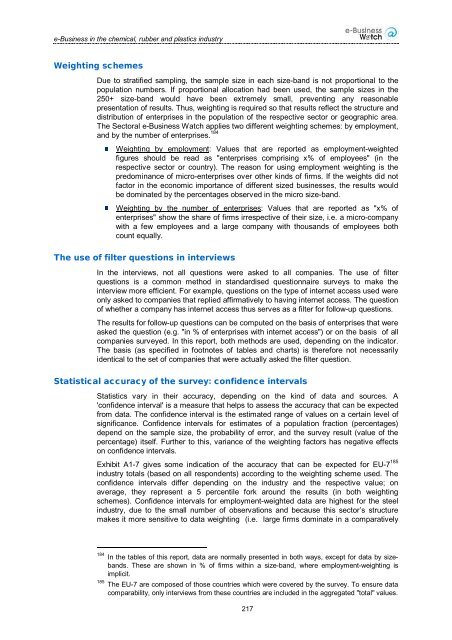Downloads - empirica
Downloads - empirica
Downloads - empirica
You also want an ePaper? Increase the reach of your titles
YUMPU automatically turns print PDFs into web optimized ePapers that Google loves.
e-Business in the chemical, rubber and plastics industryWeighting schemesDue to stratified sampling, the sample size in each size-band is not proportional to thepopulation numbers. If proportional allocation had been used, the sample sizes in the250+ size-band would have been extremely small, preventing any reasonablepresentation of results. Thus, weighting is required so that results reflect the structure anddistribution of enterprises in the population of the respective sector or geographic area.The Sectoral e-Business Watch applies two different weighting schemes: by employment,and by the number of enterprises. 184Weighting by employment: Values that are reported as employment-weightedfigures should be read as "enterprises comprising x% of employees" (in therespective sector or country). The reason for using employment weighting is thepredominance of micro-enterprises over other kinds of firms. If the weights did notfactor in the economic importance of different sized businesses, the results wouldbe dominated by the percentages observed in the micro size-band.Weighting by the number of enterprises: Values that are reported as "x% ofenterprises" show the share of firms irrespective of their size, i.e. a micro-companywith a few employees and a large company with thousands of employees bothcount equally.The use of filter questions in interviewsIn the interviews, not all questions were asked to all companies. The use of filterquestions is a common method in standardised questionnaire surveys to make theinterview more efficient. For example, questions on the type of internet access used wereonly asked to companies that replied affirmatively to having internet access. The questionof whether a company has internet access thus serves as a filter for follow-up questions.The results for follow-up questions can be computed on the basis of enterprises that wereasked the question (e.g. "in % of enterprises with internet access") or on the basis of allcompanies surveyed. In this report, both methods are used, depending on the indicator.The basis (as specified in footnotes of tables and charts) is therefore not necessarilyidentical to the set of companies that were actually asked the filter question.Statistical accuracy of the survey: confidence intervalsStatistics vary in their accuracy, depending on the kind of data and sources. A'confidence interval' is a measure that helps to assess the accuracy that can be expectedfrom data. The confidence interval is the estimated range of values on a certain level ofsignificance. Confidence intervals for estimates of a population fraction (percentages)depend on the sample size, the probability of error, and the survey result (value of thepercentage) itself. Further to this, variance of the weighting factors has negative effectson confidence intervals.Exhibit A1-7 gives some indication of the accuracy that can be expected for EU-7 185industry totals (based on all respondents) according to the weighting scheme used. Theconfidence intervals differ depending on the industry and the respective value; onaverage, they represent a 5 percentile fork around the results (in both weightingschemes). Confidence intervals for employment-weighted data are highest for the steelindustry, due to the small number of observations and because this sector’s structuremakes it more sensitive to data weighting (i.e. large firms dominate in a comparatively184 In the tables of this report, data are normally presented in both ways, except for data by sizebands.These are shown in % of firms within a size-band, where employment-weighting isimplicit.185 The EU-7 are composed of those countries which were covered by the survey. To ensure datacomparability, only interviews from these countries are included in the aggregated "total" values.217
















